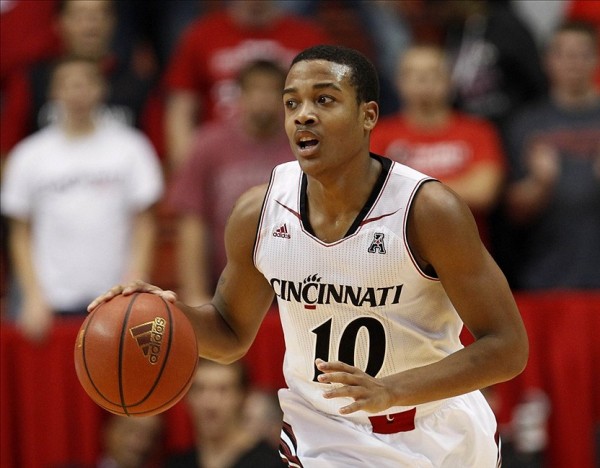It’s Well Past Time for Cincinnati to Find a Shooter
Posted by Mike Lemaire on January 15th, 2015Cincinnati basketball has grown so predictable that even trying to analyze this team has become comical; it’s almost easier to just copy and paste the same analysis from the year before. This season exhibits all the hallmarks of another stereotypical year with Mick Cronin’s Bearcats. It starts with questions about how the Bearcats are going to score points and he responds by brushing the inquiries aside as if they will seem silly once the games begin. When the season actually arrives, Cincinnati wins a bunch of games thanks to its elite defense, rebounding and above-average athleticism, but those persistent questions about offense prove legitimate as the team inevitably struggles to score. This season is no different.
The Bearcats are currently 11-4 and have already beaten the preseason conference favorite, SMU, at home. Its defense is again among the 20 most efficient in the country; its athletes again look like they could win a bodybuilding competition; and the team again boasts one of the 20 best offensive rebounding percentages in the country. Unfortunately, though, the team again struggles to put the ball in the hole, as the Bearcats have scored in the 40s and 50s more times this season (eight) than they have scored in the 70s (four). Cincinnati fans know how this will play out. The team will sneak into the NCAA Tournament if it doesn’t win the American’s automatic bid and then, faced with a better-than-advertised mid-major that can put points on the board, the Bearcats will flame out early and have to start thinking about next year.
To be fair to Cronin’s program, plenty of schools would kill for the streak of 20-win seasons (four going on five) that Cincinnati is building on the Ohio River. But it’s no leap of faith to look at the team’s elite defense and athleticism combined with a suspect offense to believe that a couple offensive tweaks could turn the team into a regular national contender. The most obvious tweak is that the Cincinnati offense needs to find a couple of shooters; Cronin has been so historically bad at finding reliable deep threats that it is baffling to even try to explain it. And believe it or not, the Bearcats are experiencing one of their worst three-point shooting seasons under his direction. The team shoots an unsightly 29.5 percent from behind the three-point line, one of the 50 marks in the country. Four players have attempted more than 30 threes this season, but only one — point guard Troy Caupain — is making more than the national average of 33.7 percent. In a perfect world, Caupain’s shooting is secondary to his role in running the offense and finding open shots for guys like Farad Cobb, Kevin Johnson, and Jermaine Sanders, but none of that trio have proven they can make those looks with any semblance of consistency.
The bigger point here is that this season’s numbers aren’t the outliers; rather, they represent an extended pattern of ineptitude from behind the three-point line. In Cronin’s nine seasons at the helm of the program, the Bearcats have never once reached the national average in three-point shooting. They came close during the 2011-12 season when Sean Kilpatrick, Cashmere Wright, and Jaquon Parker contributed toward the team’s 34.1 percent mark from behind the arc, but that was the only season in his tenure when the Bearcats have ranked better than 170th in the country. In fact, you would have to go all the way back to Cronin’s first two seasons in Cincinnati to find someone on the Bearcats’ roster who both attempted more than 100 three-pointers and made at least 40 percent of them. Poor three-point shooting as a standalone doesn’t prevent a team from being successful, but there is no question that it directly impacts a team’s offensive efficiency and puts strain on other parts of the offense. For Cronin, his team’s inability to shoot well especially problematic because his players are also bad free throw shooters and limited in their abilities to create offense off the dribble. To make matters worse, Cincinnati is regularly one of the slowest teams in the country, which means that it relies heavily on its half-court offense despite an athletic roster that should be incredibly effective in transition.
Opposing teams, of course, have figured it out the Bearcats’ fatal flaw, and rather than stretching their defense to guard them on the perimeter, teams just clog the lane and force Cincinnati to beat them in the paint. It’s pretty much basketball 101 that shooters create spacing, and spacing creates lanes and angles for slashers like Caupain and Shaquille Thomas. Without those lanes and because Cronin refuses to let his team get out in transition, Cincinnati basically just throws up contested two-pointers and plays volleyball with the miss until the ball — often accidentally — ends up in the hoop. This strategy works because the Bearcats are regularly one of the best offensive rebounding teams in the country, but it is not a tried-and-true strategy for sustained offensive success. What remains the most puzzling fact about all of this is that Cronin is smart enough to understand his team’s biggest weakness and yet he still hasn’t managed to plug that hole through recruiting. Deonta Vaughn and Kilpatrick were the best shooters Cronin has ever had at Cincinnati, and both players shot just 34 percent in their careers from downtown.
Cronin and his staff will forever know and understand more about the complexities of successful offensive basketball than me and so laying the blame at anyone’s feet seems somewhat unfair. But if Cincinnati wants to become a national title contender anytime soon, the Bearcats could do worse than finding a couple of guys who can consistently knock down shots from long range.










































